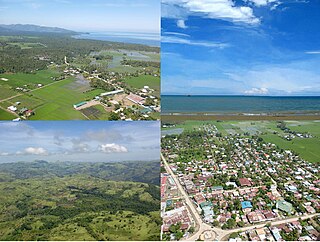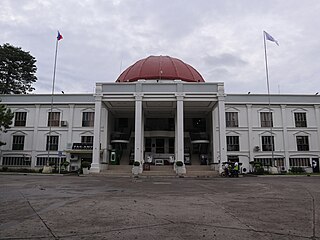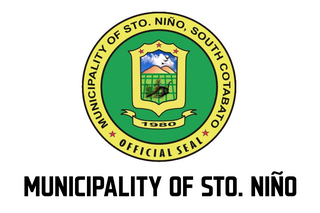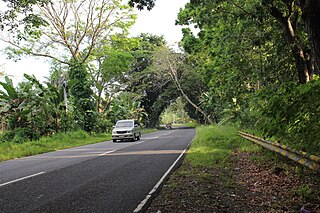Kalamansig | |
|---|---|
| Municipality of Kalamansig | |
 Public Park with Communication Tower | |
 Map of Sultan Kudarat with Kalamansig highlighted | |
Location within the Philippines | |
| Coordinates: 6°34′N124°03′E / 6.57°N 124.05°E | |
| Country | Philippines |
| Region | Soccsksargen |
| Province | Sultan Kudarat |
| District | 2nd district |
| Founded | December 29, 1961 |
| Barangays | 15 (see Barangays) |
| Government | |
| • Type | Sangguniang Bayan |
| • Mayor | Hon. Joaquin T. Concha |
| • Vice Mayor | Hon. Leslie Paez Caberte |
| • Representative | Hon. Horacio P. Suansing Jr. |
| • Municipal Council | Members |
| • Electorate | 30,492 voters (2022) |
| Area | |
• Total | 699.20 km2 (269.96 sq mi) |
| Elevation | 56 m (184 ft) |
| Highest elevation | 655 m (2,149 ft) |
| Lowest elevation | 0 m (0 ft) |
| Population (2020 census) [3] | |
• Total | 50,900 |
| • Density | 73/km2 (190/sq mi) |
| • Households | 12,083 |
| Economy | |
| • Income class | 1st municipal income class |
| • Poverty incidence | 37.83 % (2021) [4] |
| • Revenue | ₱ 293.9 million (2020), 115.8 million (2012), 126.4 million (2013), 142.6 million (2014), 160.9 million (2015), 181 million (2016), 206 million (2017), 217.1 million (2018), 258.7 million (2019), 288.7 million (2021), 388.8 million (2022) |
| • Assets | ₱ 513.6 million (2020), 123.8 million (2012), 144.1 million (2013), 139.9 million (2014), 166.4 million (2015), 201.5 million (2016), 245.3 million (2017), 289.1 million (2018), 339.2 million (2019), 565.6 million (2021), 597.5 million (2022) |
| • Expenditure | ₱ 247 million (2020), 96.96 million (2012), 110.3 million (2013), 124.6 million (2014), 133.7 million (2015), 147.8 million (2016), 172 million (2017), 183.6 million (2018), 196 million (2019), 245.5 million (2021), 316.4 million (2022) |
| • Liabilities | ₱ 145.3 million (2020), 22.85 million (2012), 56.54 million (2013), 43.44 million (2014), 50.53 million (2015), 56.69 million (2016), 245.3 million (2017, 2018), 56.35 million (2019), 163.5 million (2021), 136.4 million (2022) |
| Service provider | |
| • Electricity | Sultan Kudarat Electric Cooperative (SUKELCO) |
| Time zone | UTC+8 (PST) |
| ZIP code | 9808 |
| PSGC | |
| IDD : area code | +63 (0)64 |
| Native languages | Hiligaynon Cotabato Manobo Maguindanao Tagalog |
| Website | kalamansig |
Kalamansig, officially the Municipality of Kalamansig (Maguindanaon : Inged nu Kalamansig, Jawi: ايڠد نو كلمانسيݢ), is a municipality in the province of Sultan Kudarat, Philippines. According to the 2020 census, it has a population of 50,900 people. [3]
Contents
- Etymology
- History
- Geography
- Barangays
- Climate
- Demographics
- Economy
- Education
- Elementary
- High school
- Integrated School
- University/College
- References
- External links
The main means of livelihood of the people is farming and fishing. The municipality's marine environment is home to various species of marine wildlife and plants, the most important of which is the giant tamilok, the largest shipworm species in the world. The species can only be found within the area, and nowhere else in the world, making Kalamansig an important biodiversity area. Formerly hunted by the locals, the giant tamiloks are now strictly protected by the municipality, specifically the former hunters of the species, after research confirmed the high importance of the species in the area's biodiversity. [5]
The nearest point of entry is through Cotabato Airport, Cotabato City. The town can easily be reached by taking the fully cemented Upi-Lebak National Road. Convenient and safe public transport that plies directly to Kalamansig are also available at NCCC Mall Davao, General Santos Public Terminal, Cotabato City Lebak-Kalamansig Terminal and Tacurong City Public Terminal.
























